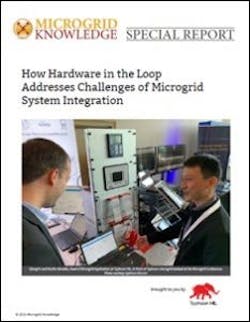In a new special report series brought to you by Microgrid Knowledge and Typhoon HIL, we’re exploring how Hardware in the Loop (HIL) can address the technical challenges that can impact the cost and scheduling of microgrid projects. In this second article in the series, we’re looking at the importance of validating a microgrid before it’s put into service.
Get the full report.
Before investing significant sums of money, a prospective microgrid owner or operator needs to explore the value proposition. Based upon desired system behaviors, such as uninterrupted operation of mission critical equipment or maximizing utilization of renewable resources, engineers scope and design a system concept. The question is, will the real system actually perform efficiently, flexibly and reliably? Traditionally, those answers have been discovered during and after installation, long after the opportunity to “get it right the first time.”
Validation for new microgrid project
Customers could view a version of their future system in validation centers such as Rolls Royce’s Friedrichshafen site in Germany, which demonstrates microgrids in operation. This gives some initial assurance, but it is an operational snippet and does not demonstrate the full range of behavior of the system. Components and systems must also pass certain certification and validation tests before they are allowed to connect to the grid and operate.
For example, an emerging microgrid interoperability standard, IEEE 2030.7 and IEEE 2030.8-2018, specifies test procedures for verification of microgrid controller performance. The standard aims to present metrics for a comparison of the control functions required from both the microgrid operator and the distribution system operator.
Validation for existing microgrids
New as well as existing microgrids face similar issues. If new components are added to an operational microgrid, testing must be carried out to ensure these are properly integrated. The new components must be able to “talk” to the rest of the system, enabling it to function effectively and safely. In addition, certification requirements can change over time, so microgrids may need to undergo recertification during their lifetime.
It is prudent to test ideas and designs as early as possible to give your project the best chance of success — and continue testing throughout its life cycle to ensure the system can deal with faults and pass validation and certification requirements.
If you missed the first article in our special report series, catch up here and learn about the evolving nature of our electrical system. In the coming weeks, this special report series will explore the following topics:
- Hardware in the Loop (HIL) — Tried and Tested.
- HIL and Microgrids.
- Model-Based Engineering.
- HIL Case Studies.
Download the full report “How Hardware in the Loop Addresses Challenges of Microgrid System Integration” courtesy of Typhoon HIL to learn more.
